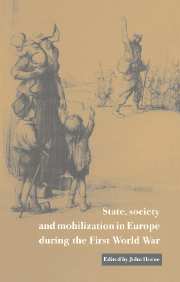Book contents
- Frontmatter
- Contents
- List of contributors
- Preface
- 1 Introduction: mobilizing for ‘total war’, 1914–1918
- I National ideals
- II Solidarities and minorities
- III Army and nation
- IV The limits and consequences of mobilization
- 12 Remobilizing for ‘total war’: France and Britain, 1917–1918
- 13 Mobilization and demobilization in Germany, 1916–1919
- 14 The Italian experience of ‘total’ mobilization, 1915–1920
- Notes
- Index
13 - Mobilization and demobilization in Germany, 1916–1919
Published online by Cambridge University Press: 04 December 2009
- Frontmatter
- Contents
- List of contributors
- Preface
- 1 Introduction: mobilizing for ‘total war’, 1914–1918
- I National ideals
- II Solidarities and minorities
- III Army and nation
- IV The limits and consequences of mobilization
- 12 Remobilizing for ‘total war’: France and Britain, 1917–1918
- 13 Mobilization and demobilization in Germany, 1916–1919
- 14 The Italian experience of ‘total’ mobilization, 1915–1920
- Notes
- Index
Summary
Writing shortly after the First World War, in his examination of the economic demobilization in Bavaria, Kurt Königsberger described the German revolution as ‘nothing other than the demobilization of the nerves’ (‘nichts anderes als die Demobilmachung der Nerven’). While this characterization of the revolutionary upheavals of 1918 and 1919 may have been something of an oversimplification, it has the merit of placing those upheavals into a revealing if often overlooked framework. By relating the revolution to the processes of demobilization in the widest sense, and thus implicitly to the processes of wartime mobilization, it suggests how the events of 1918–19 may have been linked to what had occurred in Germany during the war, and that the revolutionary unrest might be seen as a reaction to wartime political, economic and social mobilization. Viewed from this angle, the German revolution itself might appear a sort of political demobilization, and an expression of the failure of wartime attempts to mobilize the German people.
The aim of this chapter is to discuss the limits of wartime mobilization. It proceeds from the suggestion outlined above that one way to understand the ‘German revolution’ might be to regard it as a political demobilization which followed the extraordinary and ultimately unsuccessful attempts at mobilization of the war years and which paralleled the military, economic and social demobilization at the end of the conflict. Thus the attempts at economic and political mobilization during the second half of the war may be seen to have led directly to the economic and political collapse which followed.
- Type
- Chapter
- Information
- Publisher: Cambridge University PressPrint publication year: 1997
- 1
- Cited by



